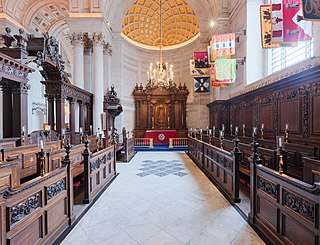
The Basilica of St. Peter, also known as St. Peter's Roman Catholic Church, is located at 1529 Assembly St. in Columbia, South Carolina. This is the second building of the oldest Catholic parish in Columbia and the Midlands of South Carolina. On June 24, 2018, it was announced that the Vatican's Congregation for Divine Worship and the Discipline of the Sacraments issued a decree granting Saint Peter's Catholic Church in Columbia the title ‘Minor Basilica.’ This makes the church the first basilica in South Carolina.

The Old Campus District, University of South Carolina, is a historic district centered on The Horseshoe on the main campus of the University of South Carolina in Columbia, South Carolina. On June 5, 1970, it was listed in the National Register of Historic Places. On April 19, 1996 MTV Unplugged filmed Hootie & the Blowfish's concert on The Horseshoe before the release of their second album Fairweather Johnson.

The James Petigru Boyce Chapel is a historic church building at 1306 Hampton Street in Columbia, South Carolina. It is a Greek Revival building built in 1859. A convention met here on December 17, 1860, whose delegates voted unanimously for South Carolina to secede from the United States, leading to the American Civil War. It was designated a National Historic Landmark as First Baptist Church, the role it played at the time.

Edward Brickell White, also known as E. B. White, was an American architect. He was known for his Gothic Revival architecture and his use of Roman and Greek designs.

The Robert Mills House, also known as Robert Mills Historic House and Park or the Ainsley Hall House, is a historic house museum at 1616 Blanding Street in Columbia, South Carolina. Built in 1823 to a design by Robert Mills, it was designated a National Historic Landmark in 1973 for its architectural significance. The Historic Columbia Foundation owns and operates the home, which has been furnished with decorative arts of the early 19th century, including American Federal, English Regency, and French Empire pieces.

This is a list of the National Register of Historic Places listings in Richland County, South Carolina.

The Hampton–Preston House located at 1615 Blanding Street in Columbia, South Carolina, is a historic mansion that was the home of members of the prominent Hampton family. It was listed in the National Register of Historic Places on July 29, 1969.

The First Presbyterian Church is a historic church building in Columbia, South Carolina. Constructed in 1854, it was added to the National Register of Historic Places on January 25, 1971.
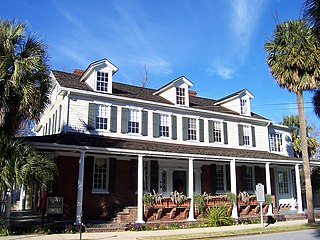
The Hale–Elmore–Seibels House or Seibels House is a historic building located in Columbia, South Carolina. Records of the exact year of its construction were destroyed in 1865 during the burning of the city by Union soldiers serving under General William Tecumseh Sherman. The best guess for the date of construction stems from a purported "1796" carved into a beam in the basement. Much of the early history of the house is uncertain, but it is thought to be the oldest building in Columbia.

Bethel A.M.E. Church is a historic African Methodist Episcopal Church at 1528 Sumter Street in Columbia, South Carolina.

Ladson Presbyterian Church is a historic African American Presbyterian church located at 1720 Sumter Street in Columbia, South Carolina. The religious building was initially a chapel founded in 1838 and, rebuilt in 1896, and is a one-story-over-raised-basement, rectangular red brick building in the Renaissance Revival style. It has a front gable roof and features two brick entrance towers. The congregation was founded in 1838, as an offshoot congregation of the First Presbyterian Church.
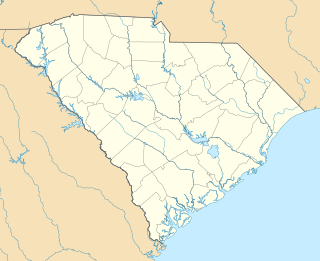
Wesley Methodist Church is a historic church at 1727 Gervais Street in Columbia, South Carolina.

Woodrow Memorial Presbyterian Church is a historic church at 2221 Washington Street in Columbia, South Carolina.

Good Hope Baptist Church is a historic Southern Baptist church located near Eastover, Richland County, South Carolina. It was built in 1857, and is a two-story, rectangular frame building. It has a front gable roof and a full height Greek Revival front portico.

Richland Presbyterian Church is a historic Presbyterian church located near Gadsden, Richland County, South Carolina. It was built in 1840 and is a one-story, rectangular meeting house form frame church with an octagonal entrance tower. The building remained in use until 1922.

The Columbia City Hall, in Columbia, South Carolina, also known as Old United States Court House and Post Office, was built in 1870. It was listed on the National Register of Historic Places in 1973. It includes Renaissance architecture. It served historically as a courthouse and as a post office.
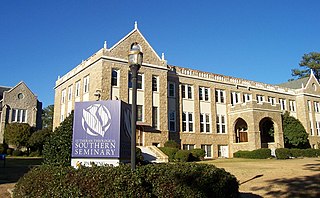
Beam Dormitory was the first permanent building at the American Lutheran Theological Southern Seminary in Columbia, South Carolina. It was built on the highest point in Columbia in 1911 based on a design by noted Virginia architect Charles M. Robinson. The structure was built by Wise Granite Co. It included a chapel, housing, refectory, classrooms, and faculty offices. Beam Hall is now used as a dormitory and also contains office suites, meeting rooms, and an exercise facility. The building was listed on the National Register of Historic Places in 1979.
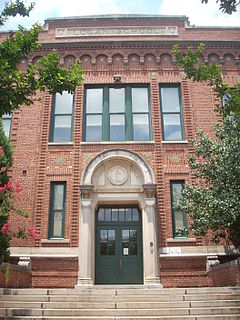
Logan Elementary School is a public elementary school in Columbia, South Carolina. It was built in 1913. The building was listed on the U.S. National Register of Historic Places in 1979.

The Palmetto Building, built during 1912-1913, is an early skyscraper in Columbia, South Carolina. It was designed by architect Julius Harder, and Wilson and Sompayrac served as supervising architects. Upon completion it was the tallest building in South Carolina.

Columbia Historic District II is a national historic district located at Columbia, South Carolina. The district encompasses 113 contributing buildings and 1 contributing site in a former residential section of Columbia. They were built between the early-19th century and the 1930s and are now mostly used for commercial purposes. The buildings are in the Greek Revival, Gothic Revival, Classical Revival, and the “Columbia Cottage” styles. Notable buildings include the Robert Mills House, Debruhl-Marshall House, Hampton-Preston House, Episcopal Church of the Good Shepherd, Crawford-Clarkson House, Maxcy Gregg House, Hale-Elmore-Seibels House, St. Paul's Lutheran Church, and Ebenezer Lutheran Church.

